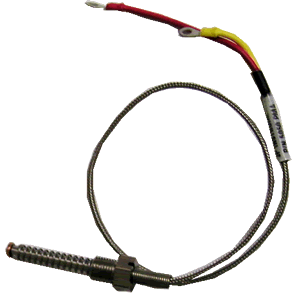 The CHT Bayonet probes are the threaded probes and are commonly known as ‘CHT Bayonet Probes’. These are typically used on Lycoming engines in aircraft.
The CHT Bayonet probes are the threaded probes and are commonly known as ‘CHT Bayonet Probes’. These are typically used on Lycoming engines in aircraft.
Let us start with extending the CHT probes - most CHT probes available in the market feature cold-junction compensation. Cold-junction compensation means that the temperature of the cold junction of the thermocouple is measured (at the RDAC) and this temperature is used to compensate for ambient temperature with the small voltage readout between the two alloys at the thermocouple junction. For this reason, it is important that type-K extension wire be used for type-K thermocouples. You can use the same extension wire for EGT’s and CHTs. The length (within reason), is not critical and will have little or no effect in the temperature reading.
Installation of CHT Bayonet probe in aircraft is actually quite simple:
1.Begin by screwing in the threaded CHT probes into recesses in cylinders (3/8-24 - no washers are required)
2.Use Thermocouple Channels TC5 through TC8 if you have a 4-cyl engine and TC7 through TC12 if you have a 6-cyl engine.
3.Remember that some CHTs are type-J thermocouples (these can be used).
4.Remember that with type-K thermocouples that Yellow is Positive and Red is Negative.
There Oil Temp Probes & Aircraft Sensor Systems extension kits available in the market and most include the type-K thermocouple wire, splice barrels, and a length of inner heat shrink tubing. When heated, this heat shrink gets quite soft inside and this eliminates all air inside the splice and makes an airtight seal. If required you and use heat shrink and we recommend you use Raychem SCL-3/16 heat shrink.
Here’s how you extend the wires of CHT Bayonet probe in Engine Monitoring Systems :
1.Use a wire stripper to strip the CHTs and make small loops with the ends.
2.Do the same with the type-K extension wire (if extension is required).
3.Prepare the splice barrels and heat shrink.
4.Place a splice barrel and short length of shrink wrap on the wires.
5.Lay the CHT and type-K extension loops over each other.
6.Slide the splice barrel over the parallel loops.
7.Crimp the splice barrel with a crimping tool (use a crimping tool with a grip for non-insulated terminals –the ones that have a cradle on one side and pierce a small hole on the other).
8.Slide the heat shrink over the splice and heat with a heat gun or lighter.
9.That is a solder-free, airtight and airless parallel thermocouple splice.
For ordering or more information, please visit: https://www.jpinstruments.com/shop/cht-bayonet-probe/

